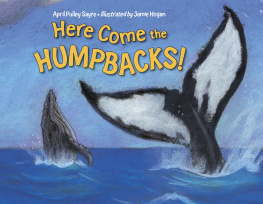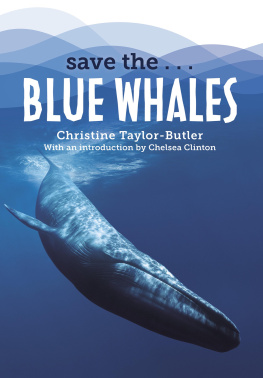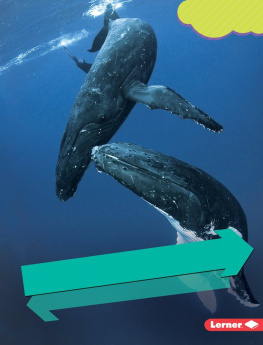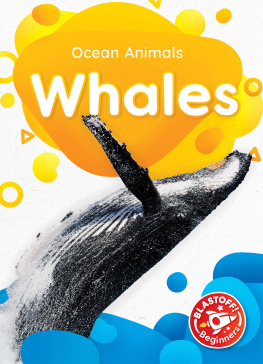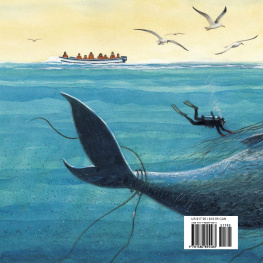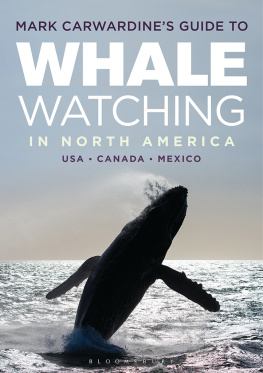
Flippers paddle. Flukes push.
In every ocean on Earth, humpback whales swim.

In the Caribbean Sea, male whales roll. They smack their flippers on the
water. Smack! Smack! They blow bubbles. Their barnacled bodies bump.
Their skin is scarred from past competitions.
A female humpback swims away to quiet shallows. Her blue-gray
head, bumpy as a pickle, lifts and looks. It is February. She is expecting
something big, something soon. The time has come.

Whats in a Name?
Humpback whales are named for the hump shape
their back makes when they dive.

Here comes a humpback!
Out, out... a whale calf slides from the female humpbacks body. She
rolls, breaking the cord that joins them. Through this cord, her body has
fed him for eleven and a half months. He will have a bellybutton where
their bodies were connected.
The mother lifts the calf. His pale gray head breaks the surface. But a
whale cannot breathe through its mouth. The calf scoots. His blowhole
meets air. Whiss, snort!

Whale Birth
Female humpback whales give birth
every one to four years. No scientist has
ever seen a humpback whale being born.
But scientists can imagine what happens
based on what is known about dolphin births.
(Dolphins are closely related to whales.)

Here breathes a humpback!
The calf is fourteen feet (a little over four meters) long and already
weighs about a ton. He dips down, latches on, and drinks milk. Up to
fifty gallons (189 liters) a day will build blubber, muscles, and energy.
The calf explores. He rubs his mothers skin. He nudges a fishs fin.
He swims loop-the-loops around his mothers tail. He listens to dolphin
whistles and the groans of fish. A loud song rises and rolls.

A Whales Spout
Whales, like people, are mammals. They cant breathe underwater as fish do.
A humpback surfaces, opens up its blowhole, and exhales. Air from its lungs
pushes any water that is on top of its blowhole into the air. This water, plus
water vapor in its breath, creates the spray we see.

Here sings a humpback!
Head down, in deeper water, a male whale sings. His song rhymes and
repeats. All the male whales in the area know this years song yet they
vary it, like jazz musicians onstage.
The calf cant sing yet. His call is a quiet grunt. He blows bubbles
that pop and hiss. He slaps his tail on the waters surface. Splash!
He and his mother nap. They float like logs, blowholes uncovered.
A boat coasts toward the sleepy whales. Will it turn away in time?

Humpback Songs
Adult male humpback whales sing songs
that can last thirty minutes. They may
repeat a song for twenty-four hours or
more. Male humpbacks sing mostly in
warm waters during breeding season
the winter. All humpbacks make shorter,
simpler calls as well.

Here comes a humpback!
An escort whale rises. He blocks the boat and slaps his tail on the water.
The captain stops her boat. Cameras click. Whale watchers stare.
The mother, calf, and escort swim away. But four shapes lurk
behind them.

Whale-Watching Rules
Conservationists and boat operators have created a set of rules to protect
whales. A good boat captain never drives a boat straight toward a whale, either
from in front or from behind. This way the whales dont feel chased or trapped.
A good captain also avoids separating one whale from another in a group and
never approaches too close to the whales. If the whales come closer on
their own, that is fine.

Here come the challengers!
Four male whales approach. Slap! One slaps the escort whale with
a flipper. Bonk! Smack! Two bump the escorts sides. A fourth whale
pushes between the escort whale and the mother. Now they are divided.
The escort whale doubles back and pushes forward. With a lunge,
he reclaims his place beside the mother-calf pair. He bumps away
another male. At last the challengers peel away.

The Escort Whale
Single adult whales often escort a
mother humpback and her calf.
People used to think that the whales
were grandmothers or aunts helping
to care for the calf. But scientists
discovered that these whales are
male. The escort whale swims along
with the mother. He waits around
in case she is ready to mate.

